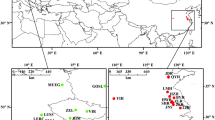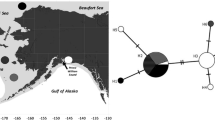Abstract
Several marine holoplanktonic organisms show a high degree of geographically structured diversity for which it often remains unclear to what extent this differentiation is due to the presence of cryptic taxa. For the genetically distinct diatom Pseudo-nitzschia pungens var. pungens, we used six microsatellite markers to investigate the spatial and temporal genetic composition in the heterogeneous Southern Bight of the North Sea. Although our sampling area (ca. 100 km) comprised water bodies with different environmental conditions (marine, estuary, saline lake) and different degrees of connectivity (from complete isolation to supposedly free exchange between environments), no evidence of genetic differentiation was found. Expanding our sampling area (ca. 650 km), suggested a homogenous population structure over even larger areas in the North Sea. Our results suggest that the population structure of this diatom is mainly shaped by strong homogenizing effects of gene flow preventing genetic drift, even in water bodies with limited connectivity.



Similar content being viewed by others
References
Amato A, Kooistra WHCF, Levialdi Ghiron JH, Mann DG, Pröschold T, Montresor M (2007) Reproductive isolation among sympatric cryptic species in marine diatoms. Protist 158:193–207
Barber PH, Palumbi SR, Erdmann MV, Moosa MK (2000) A marine Wallace’s line. Nature 406:92–693
Bucklin A, Kaartvedt S, Guarnieri M, Goswami U (2000) Population genetics of drifting (Calanus spp.) and resident (Acartia clausi) plankton in Norwegian fjords. J Plankton Res 22:1237–1251
Casteleyn G, Chepurnov VA, Leliaert F, Mann DG, Bates SS, Lundholm N, Rhodes L, Sabbe K, Vyverman W (2008) Pseudo-nitzschia pungens (Bacillariophyceae): a cosmopolitan diatom species? Harmful Algae 7:241–257
Casteleyn G, Adams NG, Vanormelingen P, Debeer AE, Sabbe K, Vyverman W (2009) Natural hybrids in the marine diatom Pseudo-nitzschia pungens (Bacillariophyceae): genetic and morphological evidence. Protist, doi:https://doi.org/10.1016/j.protis.2008.11.002
Chepurnov VA, Mann DG, Sabbe K, Vyverman W (2004) Experimental studies on sexual reproduction in diatoms. Int Rev Cytol 237:91–154
Chepurnov VA, Mann DG, Sabbe K, Vannerum K, Casteleyn G, Verleyen E, Peperzak L, Vyverman W (2005) Sexual reproduction, mating system, chloroplast dynamics and abrupt cell size reduction in Pseudo-nitzschia pungens from the North Sea (Bacillariophyta). Eur J Phycol 40:379–395
Churro CI, Carvalho CC, Rodrigues F, Craveiro SC, Calado AJ, Casteleyn G, Lundholm N (2009) Diversity and abundance of potentially toxic Pseudo-nitzschia Peragallo in Aveiro coastal lagoon, Portugal and description of a new variety, P. pungens var. aveirensis var. nov. Diatom Res (in press)
Cousyn C, De Meester L, Colbourne JK, Brendonck L, Verschuren D, Volckaert F (2001) Rapid, local adaptation of zooplankton behavior to changes in predation pressure in the absence of neutral genetic changes. Proc Natl Acad Sci USA 98:6256–6260
Darling KF, Wade CA (2008) The genetic diversity of planktic foraminifera and the global distribution of ribosomal RNA genotypes. Mar Micropaleontol 67:216–238
Darling KF, Kucera M, Pudsey CJ, Wade CM (2004) Molecular evidence links cryptic diversification in polar planktonic protists to quaternary climate dynamics. Proc Natl Acad Sci USA 101:7657–7662
De Galan S, Elskens M, Goeyens L, Pollentier A, Brion N, Baeyens W (2004) Spatial and temporal trends in nutrient concentrations in the Belgian continental area of the North Sea during the period 1993–2000. Estuar Coast Shelf Sci 61:517–528
De Vargas C, Norris R, Zaninetti L, Gibb SW, Pawlowski J (1999) Molecular evidence of cryptic speciation in planktonic foraminifers and their relation to oceanic provinces. Proc Natl Acad Sci USA 96:2864–2868
De Wolf H, Backeljau T, Blust R (2000) Heavy metal accumulation in the periwinkle Littorina littorea, along a pollution gradient in the Scheldt estuary. Sci Total Environ 262:111–121
Derycke S, Remerie T, Vierstraete A, Backeljau T, Vanfleteren J, Vincx M, Moens T (2005) Mitochondrial DNA variation and cryptic speciation within the free-living marine nematode Pellioditis marina. Mar Ecol Prog Ser 300:91–103
Derycke S, Backeljau T, Vlaeminck C, Vierstraete A, Vanfleteren J, Vincx M, Moens T (2007a) Spatiotemporal analysis of population genetic structure in Geomonhystera disjuncta (Nematoda, Monhysteridae) reveals high levels of molecular diversity. Mar Biol 151:1799–1812
Derycke S, Van Vynckt R, Vanoverbeke J, Vincx M, Moens T (2007b) Colonization patterns of Nematoda on decomposing algae in the estuarine environment: community assembly and genetic structure of the dominant species Pellioditis marina. Limnol Oceanogr 52:992–1001
Evans KM, Hayes PK (2004) Microsatellite markers for the cosmopolitan marine diatom Pseudo-nitzschia pungens. Mol Ecol Notes 4:125–126
Evans KM, Kuhn SF, Hayes PK (2005) High levels of genetic diversity and low levels of genetic differentiation in North Sea Pseudo-nitzschia pungens (Bacillariophyceae) populations. J Phycol 41:506–514
Feder JL, Chilcote CA, Bush GL (1990) The geographic pattern of genetic differentiation between host associated populations of Rhagoletis pomonella (Diptera: Tephritidae) in the Eastern United States and Canada. Evolution 44:570–594
Gerringa LJA, Poortvliet TCW, Hummel H (1996) Comparison of chemical speciation of copper in the Oosterschelde and Westerschelde estuaries, the Netherlands. Estuar Coast Shelf Sci 42:629–643
Gerringa LJA, Hummel H, Moerdijk-Poortvliet TCW (1998) Relations between free copper and salinity, dissolved and particulate organic carbon in the Oosterschelde and Westerschelde, Netherlands. J Sea Res 40:193–203
Goetze E (2005) Global population genetic structure and biogeography of the oceanic copepods Eucalanus hyalinus and E. spinifer. Evolution 59:2378–2398
Goudet J (2001) fstat, a program to estimate and test gene diversities and fixation indices (version 2.9.3). Available from http://www2.unil.ch/popgen/softwares/fstat.htm
Guo SW, Thompson EA (1992) Performing the exact test of Hardy–Weinberg proportion for multiple alleles. Biometrics 48:361–372
Halkett F, Plantegenest M, Prunier-Leterme N, Mieuzet L, Delmotte F, Simon JC (2005) Admixed sexual and facultatively asexual aphid lineages at mating sites. Mol Ecol 14:325–336
Heip C (1989) The ecology of the estuaries of Rhine, Meuse and Scheldt in the Netherlands. In: Ross JD (eds) Topics in marine biology: proceedings of the 22nd European marine biology symposium, Barcelona. Sci Mar 53:457–463
Hellberg ME, Burton RS, Neigel JE, Palumbi SR (2002) Genetic assessment of connectivity among marine populations. Bull Mar Sci 70:273–290
Koskinen MT, Haugen TO, Primmer CR (2002) Contemporary fisherian life-history evolution in small salmonid populations. Nature 419:826–830
Lee AJ (1980) North Sea: physical oceanography. In: Banner FT, Collins MB, Massie KS (eds) The North-West European shelf sea: the seabed and the sea in motion. II. Physical and chemical oceanography, and physical resources. Elsevier, Amsterdam, pp 467–493
Nagai S, Lian C, Yamaguchi S, Hamaguchi M, Matsuyama Y, Itakura S, Shimada H, Kaga S, Yamauchi H, Sonda Y, Nishikawa T, Kim CH, Hogetsu T (2007) Microsatellite markers reveal population genetic structure of the toxic dinoflagellate Alexandrium tamarense (Dinophyceae) in Japanese coastal waters. J Phycol 43:43–54
Nienhuis PH (1978) Lake Grevelingen: a case study of ecosystem changes in a closed estuary. Hydrobiol Bull 12:246–259
Palumbi SR (1994) Genetic-divergence, reproductive isolation and marine speciation. Annu Rev Ecol Syst 25:547–572
Pampoulie C, Gysels ES, Maes GE, Hellemans B, Leentjes V, Jones AG, Volckaert FAM (2004) Evidence for fine-scale genetic structure and estuarine colonisation in a potential high gene flow marine goby (Pomatoschistus minutus). Heredity 92:434–445
Park SDE (2001) Trypanotolerance in West African cattle and the population genetic effects of selection. Ph.D. thesis, University of Dublin
Peakall R, Smouse PE (2006) GenAlEx 6: genetic analysis in Excel. Population genetic software for teaching and research. Mol Ecol Notes 6:288–295
Peakall R, Smouse PE, Huff DR (1995) Evolutionary implications of allozyme and RAPD variation in diploid populations of dioecious buffalograss [Buchloe dactyloides (Nutt.) Engelm.]. Mol Ecol 4:135–147
Peijnenburg KTCA, Fauvelot C, Breeuwer AJ, Menken BJ (2006) Spatial and temporal genetic structure of the planktonic Sagitta setosa (Chaetognatha) in European seas as revealed by mitochondrial and nuclear DNA markers. Mol Ecol 15:3319–3338
Pritchard JK, Stephens M, Donnelly P (2000) Inference of population structure using multilocus genotype data. Genetics 155:945–959
Pritchard JK, Wen X, Falush D (2007) Documentation for structure software: Version 2.2. Available from http://pritch.bsd.uchicago.edu/structure.html
Rice WR (1989) Analyzing tables of statistical tests. Evolution 43:223–225
Rousset F (2008) genepop’007: a complete re-implementation of the genepop software for Windows and Linux. Mol Ecol Res 8:103–106
Rynearson TA, Armbrust EV (2004) Genetic differentiation among populations of the planktonic marine diatom Ditylum brightwellii (Bacillariophyceae). J Phycol 40:34–43
Rynearson TA, Armbrust EV (2005) Maintenance of clonal diversity during a spring bloom of the centric diatom Ditylum brightwellii. Mol Ecol 14:1631–1640
Rynearson TA, Newton JA, Armbrust EV (2006) Spring bloom development, genetic variation, and population succession in the planktonic diatom Ditylum brightwellii. Limnol Oceanogr 51:1249–1261
Smaal AC, Nienhuis PH (1992) The Eastern Scheldt (The Netherlands), from an estuary to a tidal bay: a review of responses at the ecosystem level. Neth J Sea Res 30:161–173
Soetaert K, Herman PMJ (1995) Estimating estuarine residence times in the Westerschelde (The Netherlands) using a box model with fixed dispersion coefficients. Hydrobiologia 311:215–224
Valiere N (2002) gimlet: a computer program for analysing genetic individual identification data. Mol Ecol Notes 2:377–379
Van Loon EE, Cleary DFR, Fauvelot C (2007) ares: software to compare allelic richness between uneven samples. Mol Ecol Notes 7:579–582
Van Oosterhout C, Hutchinson WF, Wills DPM (2004) micro-checker: software for identifying and correcting genotyping errors in microsatellite data. Mol Ecol Notes 4:535–538
Van Raaphorst W, Philippart CJM, Smit JPC, Dijkstra FJ, Malschaert JFP (1998) Distribution of suspended particulate matter in the North Sea as inferred from NOAA/AVHRR reflectance images and in situ observations. J Sea Res 39:197–215
Waits LP, Luikart G, Taberlet P (2001) Estimating the probability of identity among genotypes in natural populations: cautions and guidelines. Mol Ecol 10:249–256
Weir BS, Cockerham CC (1984) Estimating F-statistics for the analysis of population structure. Evolution 38:1358–1370
Wright S (1951) The genetical structure of populations. Ann Eugen 15:323–354
Acknowledgments
Financial support for this research was provided by the Research Programmes G.0292.00 and G.0197.05 of the Flemish Fund for Scientific Research (FWO) and the BOF-project GOA 12050398 of Ghent University. G.C. is funded by the Flemish Institute for the Promotion of Innovation by Science and Technology (IWT). T.B. was supported by FWO-grant G.0404.07. We thank the crew of the Zeeleeuw (VLIZ, Flemish Marine Institute) for the sampling in the North Sea and Frederik Leliaert for help with sampling in the Westerschelde, Oosterschelde and Lake Grevelingen. Andy Vierstraete is thanked for allele fragment electrophoresis.
Author information
Authors and Affiliations
Corresponding author
Additional information
Communicated by U.-G. Berninger.
Electronic supplementary material
Below is the link to the electronic supplementary material.
Rights and permissions
About this article
Cite this article
Casteleyn, G., Evans, K.M., Backeljau, T. et al. Lack of population genetic structuring in the marine planktonic diatom Pseudo-nitzschia pungens (Bacillariophyceae) in a heterogeneous area in the Southern Bight of the North Sea. Mar Biol 156, 1149–1158 (2009). https://doi.org/10.1007/s00227-009-1157-6
Received:
Accepted:
Published:
Issue Date:
DOI: https://doi.org/10.1007/s00227-009-1157-6




